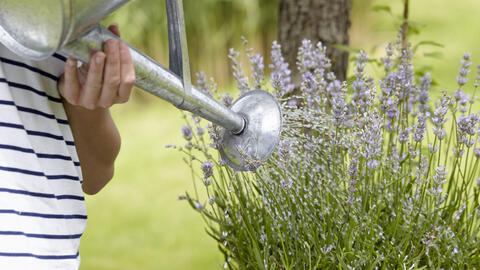Watering Lavender: Less is more
Similar to other Mediterranean plants, the Lavender is also highly sensitive to too much humidity. Be it in a pot or a flower bed. Let us show you how often you actually need to water your Lavender.

Lavender in a pot would rather stand a little drier than too moist. Only when the upper layer of soil has dried out does it need to be watered again.
Less is more – should be the motto while watering Lavenders. The popular fragrant and medicinal plant originates from the southern European Mediterranean countries, where it grows naturally on rocky and dry hillsides. Just like in its natural habitat, lavender loves a dry, lean soil and lots of sunshine. In order to be able to reach the water in deeper layers of the earth, the Mediterranean aromatic shrub forms a long taproot in the open air
Good water drainage is crucial for the growth of potted lavender. To prevent waterlogging, place a layer of clay fragments or stones on the bottom of the pot. The substrate should be mineral - one third garden soil, one third coarse sand or lime-rich gravel and one third compost. Immediately after planting the lavender, water the shrub well. To ensure that the roots develop well, keep the soil slightly moist for the first few days after planting. After that, however: Water it sparingly. Even in warm summer temperatures, Lavender needs to be watered only every few days.
Lavender in a bucket or pot cannot grow its roots freely and therefore it tends to need more water than when planted in a flower bed. A finger test is recommended to find out whether the Lavender needs watering. To do this, stick a finger about 1.18 to 1.57 inches deep into the ground. Water the lavender only if the substrate feels dry — preferably in the morning, so that the water can evaporate during the day. Listen to your intuition while watering: The soil must not be too wet, but only moderately moist. To avoid waterlogging, you should remove any excess water from the coaster immediately. Note: Unlike English lavender, the Spanish Lavender cannot tolerate lime. Hence, it is better to water it with tap water that is left to sit outside for some time, rain water or filtered water.

Outdoor Lavender does not need to be watered at all unless it is too dry. Even in this case: The better the soil is drained, the longer the plants will live. Any waterlogging — especially in winter — can kill the fragrant plant. Water the lavender only so much that the root ball doesn’t dry out. It wont hurt if the soil is completely dry for a short time. However, in case of a long dry period, check regularly if your Lavender needs water.
One more thing: Lavender appreciates being watered with warm water. Therefore the water should preferably not come directly from cold water pipes. It is better to use some stale water from the rain barrel. What might help, too: Refill the watering can immediately after watering and let it stand until the next time so that the water can warm up a little.



